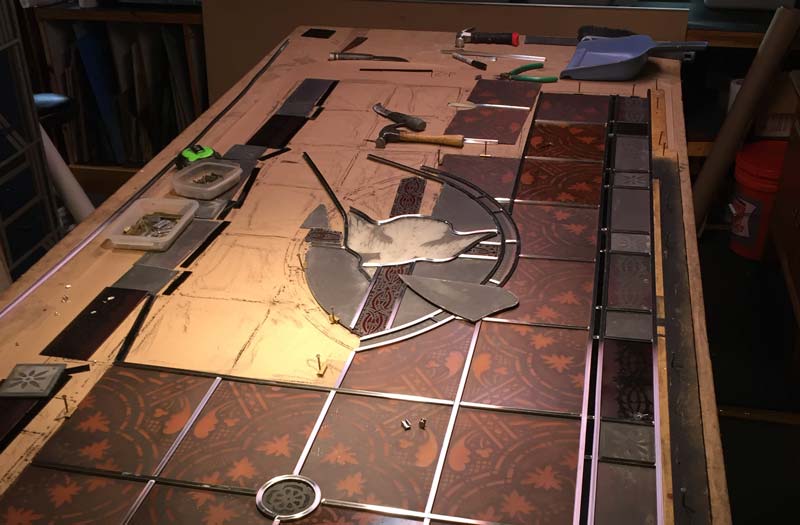
Gene Mallard Glass Arts Studio:

Glass Arts Studio was co-founded in Basel Switzerland by Gene Mallard and Dominique Raeuber, as Glas Kunst Atelier – the Swiss-German language translation of that name.
Spending a Summer Boulder Colorado, the two artists enrolled in (both) stained glass courses given by the Free University of Colorado.
Following that they returned Basel where they had already been involved in numerous creative projects. In Basel, they developed a working relationship with Hans Joachim Albert, a renowned third generation stained glass master of the old-world Germanic style.
After working with Herr Albert for a period of three years, Mallard prepared to return home to New York. At their parting, Albert proclaimed that he had completed the equivalent of a “formal” apprenticeship – and beyond during their association together.
Returning to the USA, Mallard set up his first US stained glass business on a small farm the Catskills Region of Upstate NY. He relocated to his present studio in Oneonta, NY a few years later.
Over the years he has shown in many prestigious galleries and top juried craft shows. One of his pieces was selected as the poster image for the Lincoln Center Craft Show. In addition he won a top prize in an international stained glass Fragile Art completion, as well as top prizes in the NYC Glass Masters Guild stained glass competitions. Additionally he has a number of blue ribbons from regional craft shows.
He has been an invited speaker/panelist at four national stained glass conferences and conventions held in various parts of the USA.
His work has been featured in Stained Glass Quarterly and in Professional Stained Glass Magazine. After being featured in an article in PSG, he was invited to join the staff in the roll of Painting Editor. During that time he wrote many informative articles on painting and etching on glass, as well as reviews of other artist’s work he favored. He held that post for more than five years.
In recent times he has focused on historic restorations of stained glass church windows and private commissions. He was selected from a group of the top stained glass artists in the USA participate in the World Restoration Fund’s first ever USA project to help restore the fire damaged windows of Church of the Holy Apostles in NYC.
He worked with J.R. Lamb Studios, the oldest continuously operating stained glass studio in the USA on a similar fire restoration/replication job, and his association with Lamb Studios has continued since 1990.
Independently his work continues with the fabrication and restoration of many church windows as well as private commissions over the years. Recent restorations include, the historic Unitarian Universalist Society “church” in Oneonta, NY, and the Fly Creek FUMC, just outside of Cooperstown, NY.
Important definitions:
Mouth-blown glass: Glass that is blown by mouth on the end of a tube, after gathering a glob of molten glass from a large vat. Most come from Germany or France. The resulting globe is cut open and flattened in a kiln yielding a sheet ca. 24”x 36”.
Flashed glass: Glass that is mouth-blown in such a way as to have only a paper thin layer of intense color on a body of clear glass. This is achieved by dipping a glob of clear glass into a vat of molten colored glass before the glob is blown into a globe.
Acid Etching: Acid etching is a process used to remove parts of the colored layer of flashed glass to expose the clear glass under the colored surface. This process can also be used to lighten that colored layer into various shades of the original color. The parts on which the original depth of color will be retained are covered with an acid resist, usually a product like clear Contact© plastic covering.
Painting and staining glass: Glass painting consists of three separate processes. Trace (lines) and shading (matte) paints are for lines and shading high fired at around 1250°. Enamels are for applying transparent accent colors in small quantities and fire at 1075°. Stains are used for yellow, amber, and orange, and permanently ‘stain’ the glass, firing 1000° kiln temp. Most “stained glass” does not even contain glass that was actually stained.